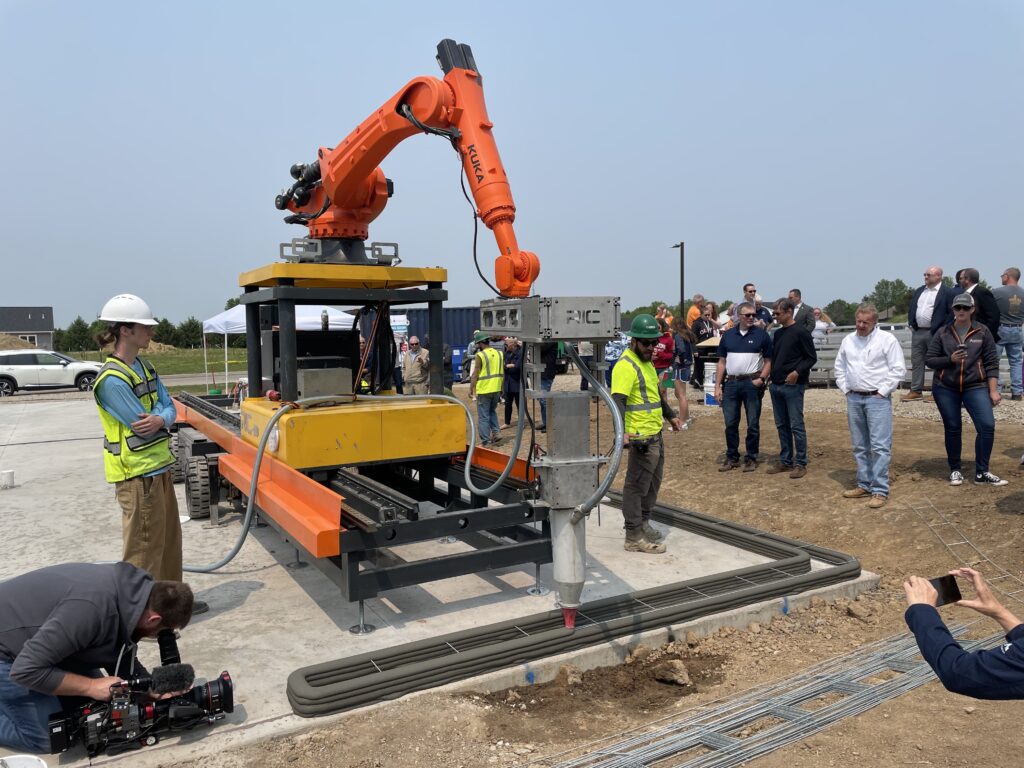RIC Technology is constructing what it is calling “the first” fire-resistant accessory dwelling unit (ADU) in Walnut, California. An ADU is a small living space that serves as a supplementary residence to the main house. It can be part of the primary home or a separate structure but must have its own entrance.
The company employs a KUKA robot arm mounted on an elevated mobile platform with a gantry to extrude concrete. This method could provide a portable and cost-effective solution if it proves stable enough. While a larger gantry might offer more stability, the current setup offers a faster and more affordable option for rapid construction. The firm promotes the unit’s fire resistance, distinguishing it from competitors that use foam, resin, or other potentially flammable thermoset materials. It’s worth noting that both the The Wildfire Resolution house—constructed by Emergent 3D using a COBOD BOD2 3D printer in Redding, California—and the Wolf Ranch home made by Lennar—using ICON’s technology in Texas—are described as fire-resistant and are full-sized homes.
Although concrete can melt and burn, its combustion point is at 1500°C, significantly higher than that of other materials. These materials might contain fire retardants, but the question remains: is it advisable to construct houses from plastic, especially when much of that plastic cannot be recycled?
“This project can be the beginning of something meaningful – a wider application of 3D printed homes that are less susceptible to fires. Our compact modular robotic 3D printer overcomes conventional gantry systems’ limitations, enabling 3D construction on site, in confined space such as people’s backyards,” said Ziyou Xu, founder and CEO of RIC Technology.
The compact system RIC Technology employs could indeed make it easier to construct an ADU in a small yard. However, a prebuilt 3D-printed home manufactured off-site might also be a suitable alternative. The system’s niche could be in creating intermediate-sized homes in confined spaces, where delivering a whole concrete home is impractical, and constructing a large gantry is unfeasible. The ADU in question is 1,200 sq ft with two bedrooms and 2.5 bathrooms, a size that would be considered a full house in Europe. Builtech Construction Group is the general contractor for the project, with K4K Construction Design handling the 3D printing.
In the US, zoning laws often restrict the placement of more than one dwelling on a single plot of land. However, states like California are increasingly permitting ADUs, allowing owners in some counties to construct separate buildings to house relatives, tenants, or use as Airbnb rentals. Lawmakers aim for ADUs to provide more flexibility in housing markets. For instance, one could reside in the main house until their children go to college, then move into the ADU and rent out the primary residence. This could bring more youthful residents into neighborhoods predominantly occupied by older couples, potentially revitalizing these areas.
The Buildtech is currently focusing on the plumbing, sewage, and foundation aspects of the project. They plan to complete the 3D printing of the walls within 20 days. This highlights how a single niche, such as 3D-printed construction for ADUs, could surpass most national markets or applications in 3D printing in terms of market size. It underscores the vast potential of 3D printing in the construction sector and emphasizes the need to explore other potential hidden billion-dollar applications within the industry.
The impact of ADUs on affordability in the housing market is yet to be determined, but the trend is growing, with ADU construction in California increasing from 1,000 units in 2016 to 23,600 in 2021. Construction costs for an ADU vary, ranging from $60,000 to $225,000. Even if the market remains stagnant, this represents a significant opportunity, especially in California, amounting to an annual $1.3 billion industry. This has attracted prebuilt home manufacturers, construction firms, and 3D printed home companies to the ADU market.
Subscribe to Our Email Newsletter
Stay up-to-date on all the latest news from the 3D printing industry and receive information and offers from third party vendors.
You May Also Like
New Report: Semiconductor Industry to See $1.4B in 3D Printing Revenues by 2032
“The semiconductor sector has become the most strategically significant area of global industry.” Truer words are hard to come by when it comes to the modern world, and they are...
Will Photonic-Crystal Lasers Revolutionize 3D Printing?
Powder bed fusion (PBF) for metals and polymers predominantly utilizes lasers as the primary heat source. Some directed energy deposition (DED) technologies also employ lasers, while various vat polymerization methods...
3D Printing Unpeeled: Orbex Investment, IndoMIM and HP, Ultrasonic Waves
INDO-MIM has bought three HP Metal Jet S100 printers, operating two in India and one in Texas. This is a win for HP because the company has deep experience in...
3D Printing Webinar and Event Roundup: April 21, 2024
It’s another busy week of webinars and events, starting with Hannover Messe in Germany and continuing with Metalcasting Congress, Chinaplas, TechBlick’s Innovation Festival, and more. Stratasys continues its advanced training...

































